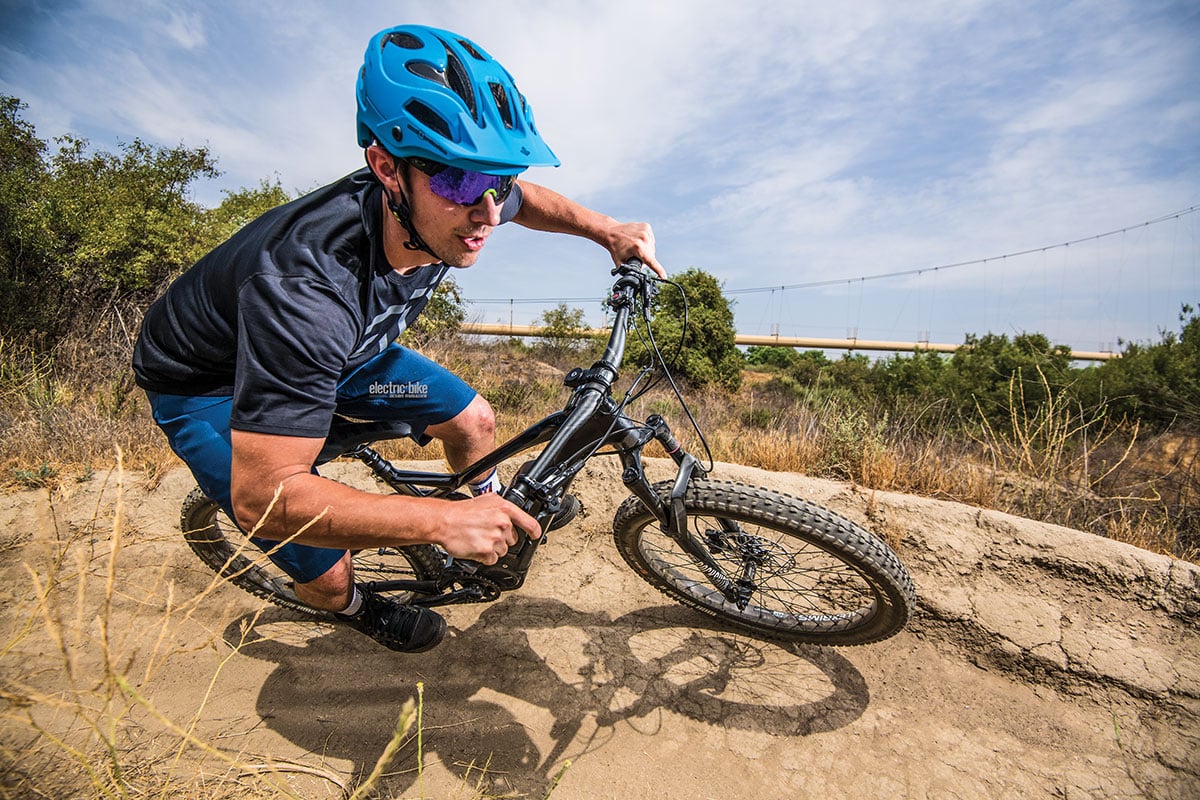Hey there, fellow E-Bike enthusiasts! Get ready to take your e-biking skills to the next level with our “Advanced E-Bike Riding Tips” series. In this section, we’re diving into the exhilarating world of controlling your downhill descents on your electric mountain bike like a pro. Whether you’re a seasoned rider or just starting to explore the thrilling terrain of mountain biking, understanding how to navigate downhill sections with ease and confidence is crucial. In this article, we’ll provide you with comprehensive insights and techniques to conquer those downhill slopes like a pro, ensuring a safe and thrilling ride every time. So, let’s buckle up and get ready for an electrifying adventure!
Choosing the Right Gear
When it comes to downhill descents on your electric mountain bike, choosing the right gear is crucial for a safe and enjoyable ride. Understanding the importance of gear selection will help you navigate the terrain with ease and control.
Understanding the Importance of Gear Selection
Gear selection is essential because it determines the effort required to pedal and maintain a certain speed. When going downhill, choosing a gear that is too high can make it difficult to control your speed and put unnecessary strain on your legs. On the other hand, selecting a gear that is too low may make it challenging to maintain momentum and control.
Factors to Consider When Choosing Gear
When deciding which gear to use during a downhill descent, there are a few factors to consider. The gradient of the trail, the type of terrain, and your riding style all play a role in gear selection. Steeper descents may require a lower gear to control speed, while smoother trails with less incline may allow for a higher gear.
How to Shift Gears Effectively
To shift gears effectively during a downhill descent, it’s important to anticipate the terrain ahead. Before reaching a hill or changing trail conditions, shift to a gear that will allow for easy pedaling and maintain a comfortable speed. Aim to shift smoothly without putting too much strain on the drivetrain. Practice shifting gears on different types of terrain to become familiar with the most efficient gear ratios for downhill descents.
Braking Techniques for Downhill Descents
Braking is a crucial skill to master when it comes to downhill descents on your electric mountain bike. Understanding proper braking technique, the different types of brakes, and making adjustments based on trail conditions will help you maintain control and stay safe.
Understanding Proper Braking Technique
When going downhill, it’s important to use both your front and rear brakes simultaneously for maximum stopping power and control. The majority of your braking should come from the front brake, as it provides the most stopping power. However, be cautious not to apply too much force to the front brake, as this can cause the bike to skid and lose control. Use your rear brake to help stabilize the bike and maintain control.
Different Types of Brakes and their Advantages
Electric mountain bikes come equipped with various types of brakes, such as hydraulic disc brakes or mechanical disc brakes. Hydraulic disc brakes offer superior stopping power and modulation, making them ideal for downhill descents. Mechanical disc brakes, while not as powerful as hydraulic brakes, still provide reliable stopping power. Consider the advantages of each type of brake and choose the one that best suits your riding style and preferences.
Trail Conditions and Braking Adjustments
Trail conditions play a significant role in determining how you should adjust your braking technique. Wet or muddy trails require more cautious braking, as the surface may be slippery. Adjust your braking force accordingly and give yourself extra time to slow down. Loose or gravelly sections of trail may also require adjustments to your braking technique. Be mindful of these conditions and adapt your braking accordingly to maintain control and stability.
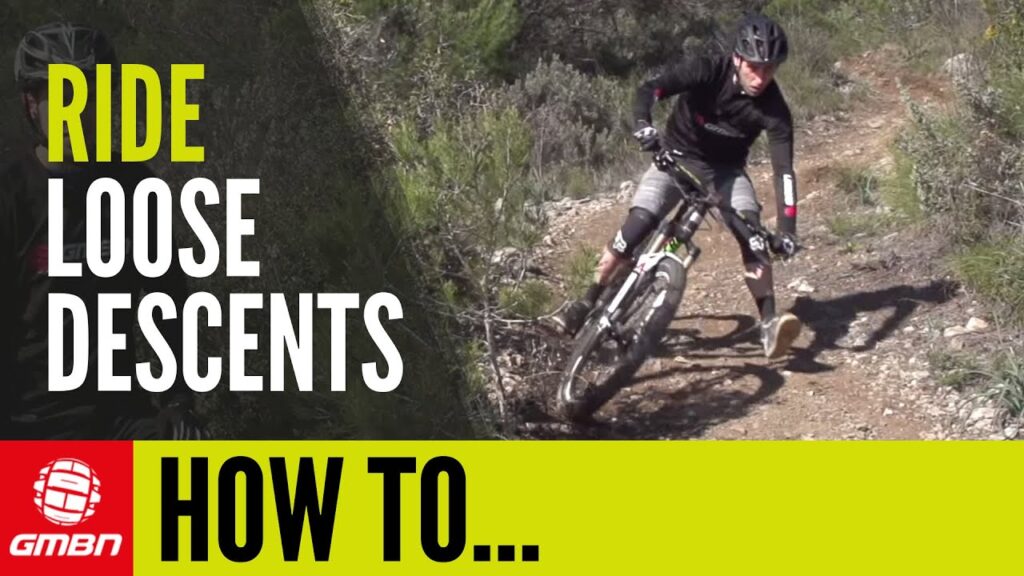
Maintaining Control and Stability
Maintaining control and stability during downhill descents is essential for a safe and enjoyable ride. Proper body positioning, using your arms and legs to absorb impact, and maintaining a firm grip on the handlebars will all contribute to your control and stability on the trail.
Body Positioning for Stability
Maintaining the correct body position is crucial for stability during downhill descents. Keep your body centered over the bike, with your knees slightly bent and your weight evenly distributed between your arms and legs. This balanced position will allow you to react quickly to changes in terrain and maintain stability.
Using Your Arms and Legs to Absorb Impact
Downhill descents can be rough and bumpy, so it’s essential to use your arms and legs to absorb impact. Bend your arms and legs to act as suspension, allowing your body to move with the terrain while keeping your bike stable. This technique will help minimize the jolts and vibrations you feel and allow you to maintain control.
Maintaining a Firm Grip on the Handlebars
A firm grip on the handlebars is crucial for maintaining control and stability. Keep your hands relaxed but firmly grip the handlebars throughout your descent. Avoid gripping too tightly, as this can lead to arm fatigue and difficulty in reacting to unexpected obstacles. By maintaining a firm grip, you’ll have greater control over your bike and be better prepared to handle any challenges that come your way.
Managing Speed and Momentum
Managing your speed and utilizing momentum effectively are essential skills for downhill descents on your electric mountain bike. Understanding how to use speed to your advantage, braking to manage speed, and harnessing momentum for easier climbing will enhance your overall riding experience.
Using Speed to Your Advantage
Maintaining a controlled and comfortable speed is crucial during downhill descents. Utilize the terrain to your advantage and allow gravity to assist you in gaining speed. Avoid constantly braking and try to find a balance between maintaining control and utilizing the momentum provided by the slope.
Brake Control to Manage Speed
While it’s important to use speed to your advantage, it’s equally important to have control over your descent. Utilize your braking techniques to manage your speed and maintain a comfortable pace. Be mindful of your surroundings and anticipate any potential hazards or obstacles that may require sudden speed adjustments.
Utilizing Momentum for Easier Climbing
One of the benefits of a well-executed downhill descent is the momentum it provides for easier climbing. By maintaining a consistent speed and utilizing your body positioning and gear selection effectively, you can carry momentum into uphill sections of the trail. This will reduce the effort required to climb and allow you to conserve energy for the rest of your ride.
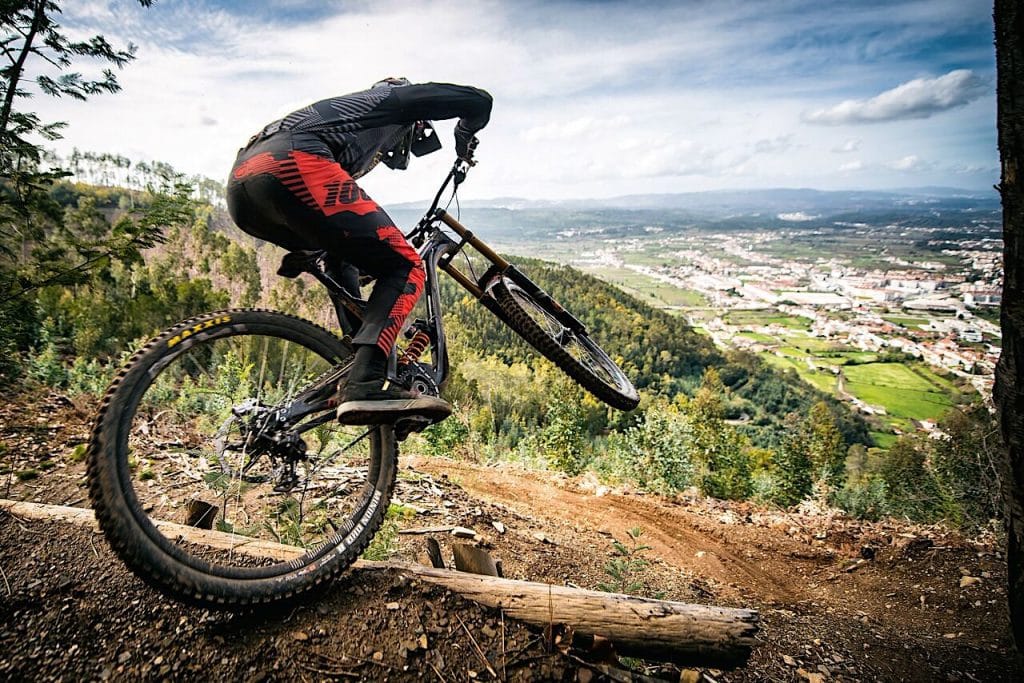
Reading the Trail
Reading the trail ahead is an essential skill for navigating downhill descents on your electric mountain bike. Being able to identify obstacles and potential hazards, analyze the terrain, and anticipate changes in trail conditions will allow you to navigate with confidence and maintain control.
Identifying Obstacles and Potential Hazards
As you ride downhill, it’s crucial to constantly scan the trail ahead and identify any obstacles or potential hazards. Look out for rocks, roots, fallen branches, or any other objects that can interfere with your path. By identifying these obstacles early on, you can adjust your line and approach to ensure a smooth ride.
Analyzing the Terrain and Choosing the Best Line
Analyzing the terrain is a key aspect of reading the trail. Look for the most favorable line that will provide the smoothest descent. Factors such as the composition of the trail, its gradient, and any natural features like berms or drop-offs should be considered when choosing your line. By selecting the best line, you can maintain control and minimize the impact on the bike and your body.
Anticipating Changes in Trail Conditions
The trail conditions can change quickly, especially during downhill descents. Anticipating these changes is essential for maintaining control and adjusting your riding technique accordingly. Be aware of upcoming sections that may be wet, loose, or have sudden turns. By anticipating these changes, you can adapt your speed, braking, and line selection to ensure a safe and smooth descent.
Body Position and Weight Distribution
Proper body position and weight distribution are key elements in maintaining control and improving handling during downhill descents. Understanding the optimal body position for stability, distributing your body weight effectively, and adjusting your body position for different trail features will enhance your overall riding experience.
Optimal Body Position for Stability and Control
The optimal body position for stability and control during downhill descents involves keeping your weight centered over the bike. Bend your knees slightly, allowing them to act as suspension, and keep your arms and elbows relaxed. By keeping a low and balanced position, you’ll have better control over the bike and be able to react quickly to changes in terrain.
Distribution of Body Weight for Improved Handling
Distributing your body weight effectively can greatly improve the handling of your electric mountain bike during downhill descents. As you navigate through turns or technical sections, shift your body weight to the appropriate areas. This might mean leaning back slightly for better traction on steep descents or shifting forward for improved maneuverability through tight turns. Experiment with different weight distributions to find what works best for your riding style and the specific trail features.
Adjusting Body Position for Different Trail Features
Different trail features require adjustments to your body position to maintain control and stability. When approaching drops or jumps, bend your knees and compress your body to absorb the impact upon landing. For off-camber sections or uneven terrain, consider adjusting your body position to counterbalance the bike’s movements and maintain stability. By adapting your body position to the trail features, you’ll be better prepared to face any challenges that come your way.
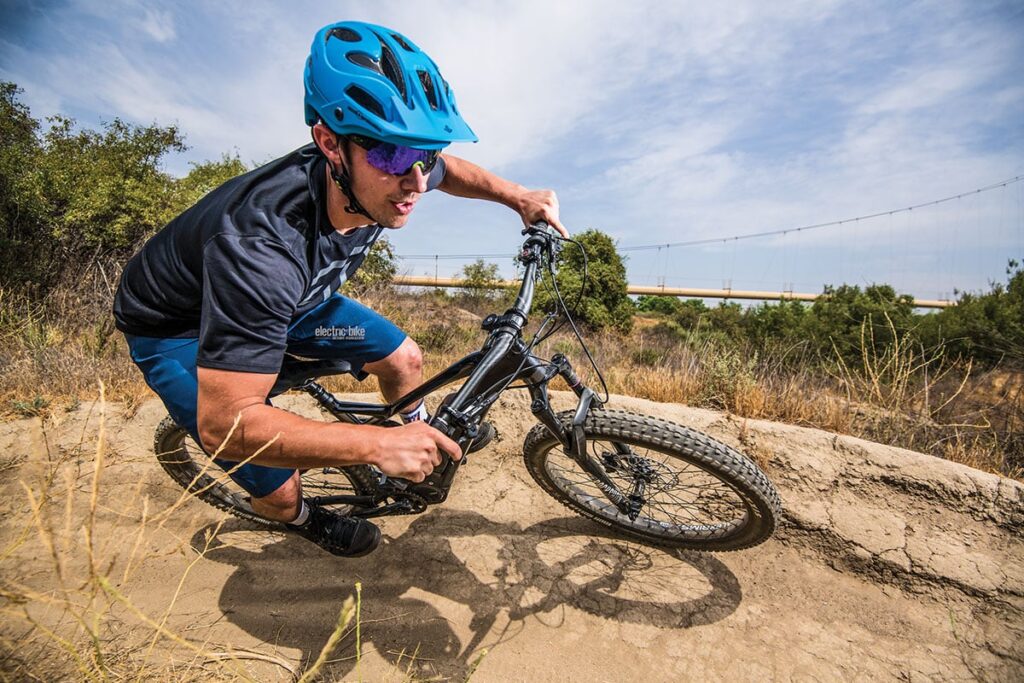
Using Suspension to Your Advantage
Understanding how to use your bike’s suspension to your advantage is essential for a smooth and controlled descent. By grasping the basics of suspension, dialing in the suspension settings for descents, and properly maintaining and servicing suspension components, you can maximize the performance of your electric mountain bike.
Understanding the Basics of Suspension
Suspension is a vital component of an electric mountain bike and greatly influences its performance on downhill descents. It helps absorb impacts, smooth out rough trails, and improves traction. Familiarize yourself with the different types of suspension systems, such as fork suspension and rear shock suspension, and understand their role in providing a more comfortable and controlled ride.
Dialing in Suspension Settings for Descents
To optimize your bike’s suspension for downhill descents, it’s essential to dial in the right settings. Factors such as rider weight, trail conditions, and personal preferences all play a part in adjusting suspension settings. Experiment with different settings, including compression and rebound adjustments, to find the ideal setup that provides the desired level of control and comfort.
Maintaining and Servicing Suspension Components
Regular maintenance and servicing of your bike’s suspension components are necessary to ensure optimal performance. Keep your suspension clean, check for any signs of wear or damage, and follow the manufacturer’s recommended maintenance schedule. If you’re unsure about how to properly maintain or service your suspension, consult with a professional bike mechanic to ensure everything is in good working order.
Handling Tight Turns and Switchbacks
Tight turns and switchbacks are common obstacles encountered during downhill descents. Knowing the techniques for navigating these challenging sections, approaching them with confidence, and maintaining balance and control will help you conquer them like a pro.
Techniques for Navigating Tight Turns
When faced with tight turns, it’s important to approach them with the right technique. Slow down before entering the turn and shift your body weight to the outside of the turn. Keep your eyes focused on the exit of the turn and lean your bike slightly to maintain traction. Practice these techniques in a controlled environment to build confidence and improve your ability to navigate tight turns.
Approaching Switchbacks with Confidence
Switchbacks can be particularly challenging due to their sharp turns and sudden changes in direction. Approach switchbacks with confidence by adjusting your speed and line before entering the turn. Use your body positioning to lean into the turn and maintain a controlled speed. Practice riding switchbacks on a variety of terrains to gain experience and improve your ability to navigate these challenging sections.
Maintaining Balance and Control in Turns
Maintaining balance and control in turns is crucial for a successful downhill descent. Focus on keeping a neutral body position and distributing your body weight evenly between your arms and legs. Be mindful of your bike’s momentum and adjust your speed and braking accordingly. By maintaining balance and control throughout the turn, you’ll be able to navigate it smoothly and confidently.
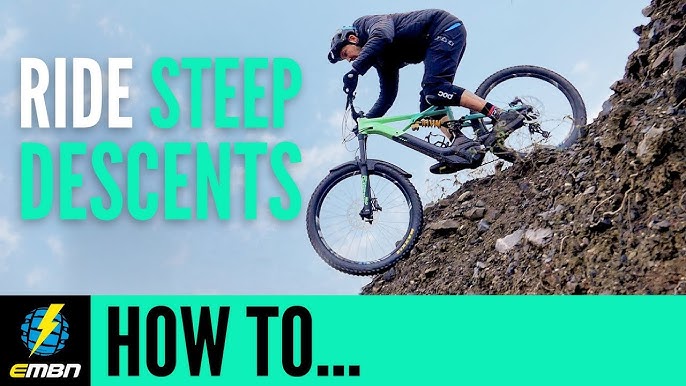
Preparing for Technical Descents
Technical descents require advanced skills and preparation to navigate successfully. Assessing the difficulty of the descent, identifying and preparing for technical features, and developing a strategy will help you tackle challenging descents with confidence.
Assessing the Difficulty of the Descent
Before embarking on a technical descent, it’s essential to assess the difficulty level and determine whether it aligns with your skill level and experience. Consider factors such as the steepness of the trail, the presence of obstacles or drops, and the overall technicality of the terrain. If you feel overwhelmed or uncertain, it’s best to take a cautious approach and potentially walk or dismount if necessary.
Identifying and Preparing for Technical Features
Technical descents often include various features that require specific skills and techniques to navigate successfully. Take the time to identify these features, such as rock gardens, drop-offs, or tight chutes, and prepare accordingly. Practice these skills in controlled environments first before attempting them on more challenging trails. By building your skills and confidence in handling technical features, you’ll be better equipped to tackle them during descents.
Developing a Strategy for Challenging Descents
Having a strategy in place for challenging descents can greatly improve your chances of success. Analyze the descent, identify the most critical sections, and plan your approach. Consider the optimal line selection, the use of braking and body positioning, and how to maintain control and stability throughout. By developing a strategy and visualizing your approach, you’ll be prepared to tackle challenging descents with confidence.
Safety Considerations
While downhill descents on your electric mountain bike can be thrilling, it’s essential to prioritize safety. Wearing proper safety gear, riding within your skill level and comfort zone, and knowing when to walk or dismount are all crucial factors in ensuring a safe riding experience.
Wearing Proper Safety Gear
Wearing proper safety gear is vital when engaging in downhill descents. Always wear a properly fitted helmet to protect your head in the event of a fall. Additionally, consider wearing knee and elbow pads, as well as gloves and appropriate footwear. Protective gear will minimize the risk of injuries and provide added confidence during challenging descents.
Riding within Your Skill Level and Comfort Zone
It’s important to ride within your skill level and comfort zone when attempting downhill descents. Pushing your limits too far can lead to accidents and injuries. Be honest with yourself about your abilities and gradually progress to more challenging terrain. If you feel overwhelmed or unsure about a particular descent, it’s best to take a step back and ride within your comfort zone.
Knowing When to Walk or Dismount
There may be instances during a downhill descent when it’s best to walk or dismount from your electric mountain bike. If you encounter a section that surpasses your skill level or poses a significant risk, it’s wise to prioritize your safety and dismount. Additionally, if you’re feeling fatigued or unsure of your abilities, it may be a good idea to take a break or choose an alternate route. Remember, knowing when to walk or dismount is a sign of maturity and responsible riding.
In conclusion, mastering the art of downhill descents on your electric mountain bike requires a combination of skills, techniques, and careful consideration. By choosing the right gear, understanding proper braking techniques, maintaining control and stability, managing speed and momentum, reading the trail, utilizing body position and weight distribution, optimizing suspension, handling turns and switchbacks, preparing for technical descents, and prioritizing safety, you’ll be able to control your descent like a pro and ensure a safe and exhilarating ride. So get out there, practice these techniques, and enjoy the thrilling world of downhill descents on your electric mountain bike!

